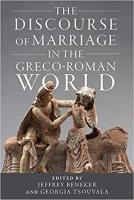
Wisconsin (2020) h/b 272 £94.95 (ISBN 9780299328405)
Marriage was of central importance to ancient social and political life, and this collection of essays charts its development throughout the centuries of the late Hellenistic period and early Roman Empire, with contextualising references reaching as far back as the wedding poems of Sappho and the François vase of the early 7-6th c. BC and forward to the epithalamia of Claudian and the world of the Greek novels of the late 4th C AD. The book grew from a panel at the International Plutarch Society in 2013 and is centred around Plutarch himself, chiefly his Marriage Advice, 48 precepts composed as a wedding gift for two of his former pupils, in addition to other related works.
The book is aimed at ‘students and scholars of classics, ancient history, philosophy, art, archaeology, and gender and women’s studies, as well as…those who are interested in the history of the family’ (p. 4). Source material is translated or glossed in English and the eight contributions are arranged by topic in a loosely chronological framework, each with its own extensive notes and bibliography and employing detailed analysis in a wide range of specialist areas: from art and epithalamia to philosophy, tragedy and the Greek novel.
The first essay focusses on wedding iconography in late Classical and Early Hellenistic pots, with numerous relevant illustrations, including several coloured plates. It surveys seven key vases depicting the stages of the Greek marriage ceremony, pointing out the resemblance of weddings to mystery cult initiation in their rituals of sacrifice, bathing and torch-lit processions with music and dancing which culminate in the final unveiling as a revelation of the unknown with the promise of a happier and better life hereafter.
The second essay explores a much harsher resemblance between the rituals of Roman weddings and funerals, showing how the marriage ceremony re-enacted the rape of the Sabine women with the symbolic abduction of the bride from her family. The bride is represented as a war captive enduring the symbolic death of her previous identity and functioning as a sacrifice on behalf of the state, where her resistance to the yoke of marriage forms a public display of her chastity and shows the similarity in the Roman male psyche between the subjugation of the enemy in war and of the wife in the bedroom.
Following essays deal with the relationship between Plutarch’s Marriage Advice and the tradition of poetic epithalamia by Sappho, Theocritus, Catullus, Statius, Claudian and later epideictic wedding speeches; and explore the attitude of Epicurus to marriage, discussing the way wife and children can be a source of misery to the philosopher by undermining his tranquillity of mind and self-sufficiency, and concluding that marriage is best avoided by him except in rare circumstances.
The fifth essay discusses fragments of a lost philosophical treatise by Seneca on marriage preserved in a later 4th C AD Christian text and suggests the possibility of alternatives to traditional patriarchal marriage through the negative attitudes of Seneca’s tragic female heroines. Next is an essay on three of Plutarch’s works which use the anthropomorphised behaviour of animals and birds like kingfishers and hippopotami to illustrate natural models of child-rearing and sexual morality and show through gender biased behaviour that the natural purpose of marriage is procreation, not pleasure.
The seventh essay explores Plutarch’s recognition of women’s capacity for virtue and how voluntary moderation of sexual desire and mutual devotion of spouses leads to a well-ordered household, idealising the univira in a relationship where the older husband leads, teaches and guides his typically younger partner, who can act independently, but only when he is absent or dead, citing the examples of Camma, Porcia and Cornelia, mother of the Gracchi.
The final essay investigates erôs as a prerequisite to marriage in the Greek novels of the 2nd, 3rd and 4th C AD, indicating the shift towards a situation where passion is becoming a basis for unarranged matches, where the hero and heroine spend time together before marriage or the re-celebration of an earlier unstable alliance, affirming mutual love after experiencing a range of alternative paths, and suggesting that erotic passion is natural but wedlock is only the artificial ideal outcome.
The book’s stated aim is to set Plutarch’s work within its cultural and intellectual context and it does a good job of demonstrating how the traditional expectations of marriage as a match between two families arranged principally by fathers to promote their status and political influence were gradually giving way because of the greater freedom and financial independence enjoyed by some women to a new ideal of an emotional and sexual bond existing between a married couple, thus creating tension between sexual passion and procreative marriage for the good of the family and state.
Claire Gruzelier
